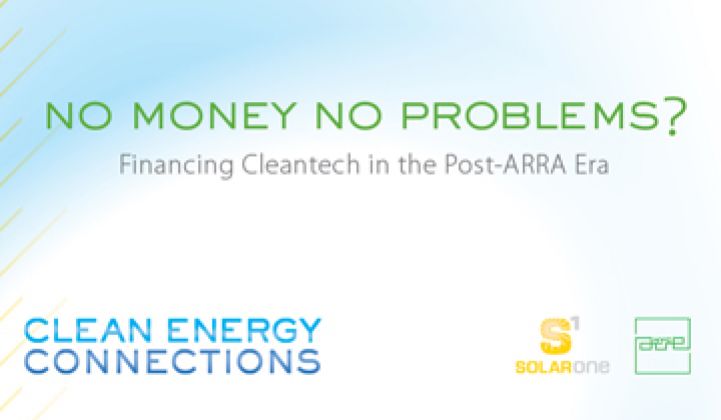Tonight, experts in finance and cleantech will be discussing the new era of renewable energy funding at the latest Clean Energy Connections panel in New York City.
Moderator Michael Molnar of Greentech Capital Advisors will guide the panelists as they offer a realistic assessment of where cleantech is headed now that the appetite for tax equity has diminished.
Need to brush up on renewable energy finance before you tune in to the livestream of the panel (available after the jump at 7:00 p.m. EST)? GTM Research recently published Renewable Energy Project Finance in the U.S.: 2010-2013 Overview and Future Outlook in collaboration with law firm Mintz Levin. The greenpaper provides an analysis of project financing trends for utility-scale renewable power projects in the U.S., as well as forecasting the anticipated supply and demand levels through 2013.
To read the full paper, download it here.
Hindsight: 2010 & 2011
Since the fourth quarter of 2008, the ability of U.S. renewable power projects to secure both equity and debt project financing decreased precipitously due to the systemic turmoil experienced in the global financial markets. As we approach the third anniversary of that economic crisis, the prospects for project financing have improved considerably due to several market trends and significant legislative policy support mechanisms, including increased liquidity in the debt markets, lower costs of capital attributable to reduced debt spreads and the DOE’s loan guarantee programs.
Other notes from the past few years:
- In 2010, renewable energy projects secured a total of $18.5 billion in debt and equity capital.
- From 2009 through 2011, the 1603 Cash Grants provided significant liquidity to renewable project developers by allowing thousands of projects to directly monetize the 30 percent and 10 percent Investment Tax Credits. This resulted in $9.78 billion in distributed 1603 Cash Grants to 4,254 projects.
- Assuming private sector investments constituted the remaining 70 percent of project costs, the 1603 Cash Grants catalyzed approximately $22.8 billion in additional investment for a total deployment of approximately $32.6 billion.
Foresight: 2012-2013
Looking ahead, the three factors that could have the most negative impact on future capital formation will be: 1) the December 2011 expiration of the 1603 Cash Grants; 2) the December 2012 expiration of the Production Tax Credit (PTC) for wind; and 3) macro-trends in tax equity financing.
According to the findings outlined in the paper, we expect the renewable power sector to seek over $90 billion in project financing for 2012-2013. The variables in interest rate trends, the financial health of institutions providing tax equity, and congressional legislation will have the most impact on the availability of debt, tax equity, and direct equity.
Live Panel Broadcast
Come back to this article at 7:00 p.m. EST on Tuesday, January 31 to view the live panel discussion. Leave comments below to ask questions (before or during the event). You can also follow the discussion on Twitter through @cleanECnyc or with hashtag #cleanNRGx.
After the event has concluded, we will post the full archive version here for viewing.




